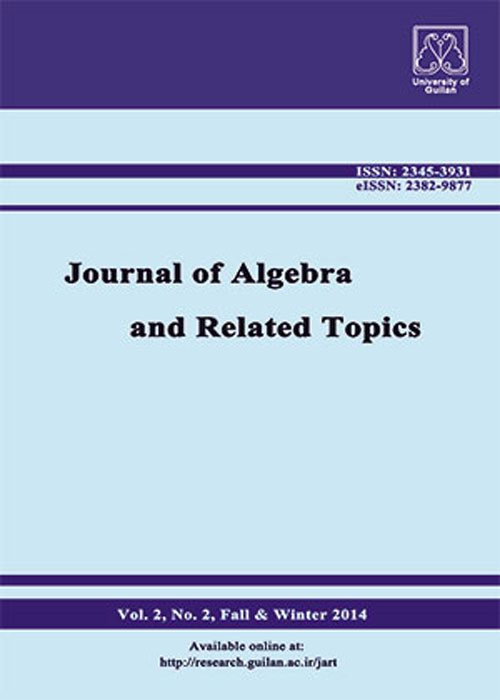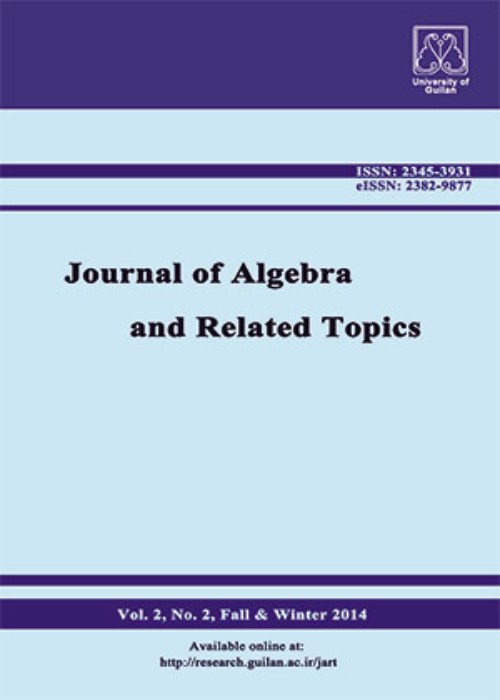فهرست مطالب

Journal of Algebra and Related Topics
Volume:10 Issue: 1, Spring 2022
- تاریخ انتشار: 1401/04/12
- تعداد عناوین: 12
-
-
Pages 1-10
This paper is concerned with S-comultiplication modules which are a generalization of comultiplication modules. In section 2, we introduce the S-small and S-essential submodules of a unitary R-module M over a commutative ring R with 1≠0 such that S is a multiplicatively closed subset of R. We prove that if M is a faithful S-strong comultiplication R-module and N≪SM, then there exist an ideal I≤SeR and an t∈S such that t(0:MI)≤N≤(0:MI). The converse is true if S⊆U(R) such that U(R) is the set of all units of R. Also, we prove that if M is a torsion-free S-strong comultiplication module, then N≤SeM if and only if there exist an ideal I≪SR and an s∈S such that s(0:MI)≤N≤(0:MI). In section 3, we introduce the concept of S-quasi-copure submodule N of an R-module M and investigate some results related to this class of submodules.
Keywords: S-small submodule, S-essential submodule, S-co-m module -
Pages 11-33
Let f:A→B be a ring homomorphism and let J be an ideal of B. We proved some results concerning n-ideals and (2; n)-ideals of A⋈^f J. Then we recall a proper ideal I of A as √(δ(0))-ideal if ab ϵ I then b ∈ I or a ∈ √(δ(0)) for every a; b ∈ A. We investigate some properties of √(δ(0))-ideal with similar n-ideals and J-ideals.
Keywords: n-ideal, (2, n)-ideal, J-ideal, √(δ(0))-ideal -
Pages 35-50
Let R be a commutative ring with identity and M be an R-module. It is shown that the usual lattice V(RM) of varieties of submodules of M is a distributive lattice. If M is a semisimple R-module and the unary operation ′ on V(RM) is defined by (V(N))′=V(N~), where M=N⊕N~, then the lattice V(RM) with ′ forms a Boolean algebra. In this paper, we examine the properties of certain mappings between V(RR) and V(RM), in particular considering when these mappings are lattice homomorphisms. It is shown that if M is a faithful primeful R-module, then V(RR) and V(RM) are isomorphic lattices, and therefore V(RM) and the lattice R(R) of radical ideals of R are anti-isomorphic lattices. Moreover, if R is a semisimple ring, then V(RR) and V(RM) are isomorphic Boolean algebras, and therefore V(RM) and L(R) are anti-isomorphic Boolean algebras.
Keywords: Lattice homomorphism, $omega$-module, Primeful module, Semisimple ring -
Pages 51-61
Let R be a finite local ring of characteristic a power of 2 with the residue field k. In this paper, we define a generalized orthogonal graph on a module of rank at least 2 over R. Then we study its graph properties via the same graph over k. The number of vertices and the valency of each vertex in this graph over R are computed. We also prove that this graph is arc transitive and find its diameter. Moreover, the first subconstituent of this orthogonal graph is considered. We show that it is a generalized strongly regular graph.
Keywords: Generalized strongly regular graphs, Local rings, Orthogonal graphs -
Pages 63-69
Let R be an associative ring with involution ∗. An additive map λ→λ∗ of R into itself is called an involution if the following conditions are satisfied (i)(λμ)∗=μ∗λ∗, (ii)(λ∗)∗=λ for all λ,μ∈R. A ring equipped with an involution is called an ∗-ring or ring with involution. The aim of the present paper is to establish some results on ∗-α-derivations in ∗-rings and investigate the commutativity of prime ∗-rings admitting ∗-α-derivations on R satisfying certain identities also prove that if R admits a reverse ∗-α-derivation δ of R, then α∈Z(R) and some related results have also been discussed.
Keywords: Prime *-ring, *- α- derivation, reverse *- α-derivation -
Pages 71-94
An R-module M is called torsion-free, if rx=0 for r∈R and x∈M implies that r=0 or x=0. In this paper, we introduce the notions semi torsion-free modules and quasi torsion-free modules. We show that a submodule N of an R-module M is a P-primary submodule if and only if RP-module MN is semi torsion-free. Also we define a new radical in free modules and find some characterizations of it. We prove that for P-submodule N of a free R-module F which N−−√⫋F, we have for any r∈R and m∈F, rm∈N implies r∈P−−√ or m∈N−−√ if and only if RP-module FN is quasi torsion free.
Keywords: prime submodule, primary submodule, Free module -
Pages 95-111
It is known that all subvarieties of variety of all semigroups are not absolutely closed. So, it is a natural question to find out those subvarieties of variety of all semigroups that are closed in itself or close in larger subvarieties of variety of all semigroups. We have gone through this open problem and able to determine some closed varieties of semigroups defined by the identities axy=yxax [axy=xyxa] and axy=yxxa by using Isbell's zigzag theorem as an essential tool. Further, we partially generalize a result of Isbell on semigroup dominions from the class of commutative semigroups to some generalized classes of commutative semigroups by showing that dominions of such semigroups belong to the same class.
Keywords: Zigzag equations, varieties, Identities, Closed -
Pages 113-118In this paper, We define Jordan algebra bundles of finite type and we give one-one correspondence between Jordan algebra bundles of finite type and Jordan rings.Keywords: Jordan algebra bundle, Lie algebra bundle, Vector bundle
-
Pages 119-128
Let R be a commutative ring with nonzero identity and H be a nonempty proper subset of R such that R/H is a saturated multiplicatively closed subset of R. Anderson and Badawi [4] introduced the generalized total graph of R as an undirected simple graph GTH(R) with vertex set as R and any two distinct vertices x and y are adjacent if and only if x + y ϵ H. The main objective of this paper is to study the domination properties of the graph GTH(R). We determine the domination number of GTH(R) and its induced subgraphs GTH(H) and GTH(R/H). We establish a relationship between the domination number of GTH(R) and the same of GTH(R/H). We also establish a relationship between diameter and domination number of GTH(R/H). In addition,we obtain the bondage number of GTH(R). Finally, a relationship between girth and bondage number of GTH(R/H) has been established.
Keywords: Bondage number, Commutative ring, Domination number, Generalized total graph -
Pages 129-141
Let M be a Noetherian R−module. In this paper we will introduce the integral closure of a filtration F={In}n≥0 relative to the Noetherian module M and prove some related results.\\ The integral closure of a filtration F={In}n≥0 relative to M is a filtration and it has an interesting relationship with the integral closure of the filtration F˜={I˜n}n≥0, where I˜n is the image of In under the natural ring homomorphism R→R/(AnnR(M)) for every n≥0.
Keywords: Filtration, Reduction of a filtration, Noetherian filtration, Integral closure of a filtration -
Pages 143-158In this paper we extend a result of Scheiblich by showing that variety of po-normal bands is closed. We also extend the well known results to posemigroups namely, that pogroups and inverse posemigroups have special amalgamation property in the category of all posemigroups and commutative posemigroups, respectively. Finally, we find some varieties of posemigroups which are closed if they are self convex.Keywords: Posemigroup, Dominion, Zigzag Inequalities, Permutative, variety
-
Pages 159-169
This paper investigates the structure of the quotient ring R/P, where R is an arbitrary ring and P is a prime ideal of R . We show that the structure of this class of rings has a relationship with the behaviour of generalized derivations satisfying algebraic identities involving prime ideals.
Keywords: prime ideal, Generalized derivations, integral domain


